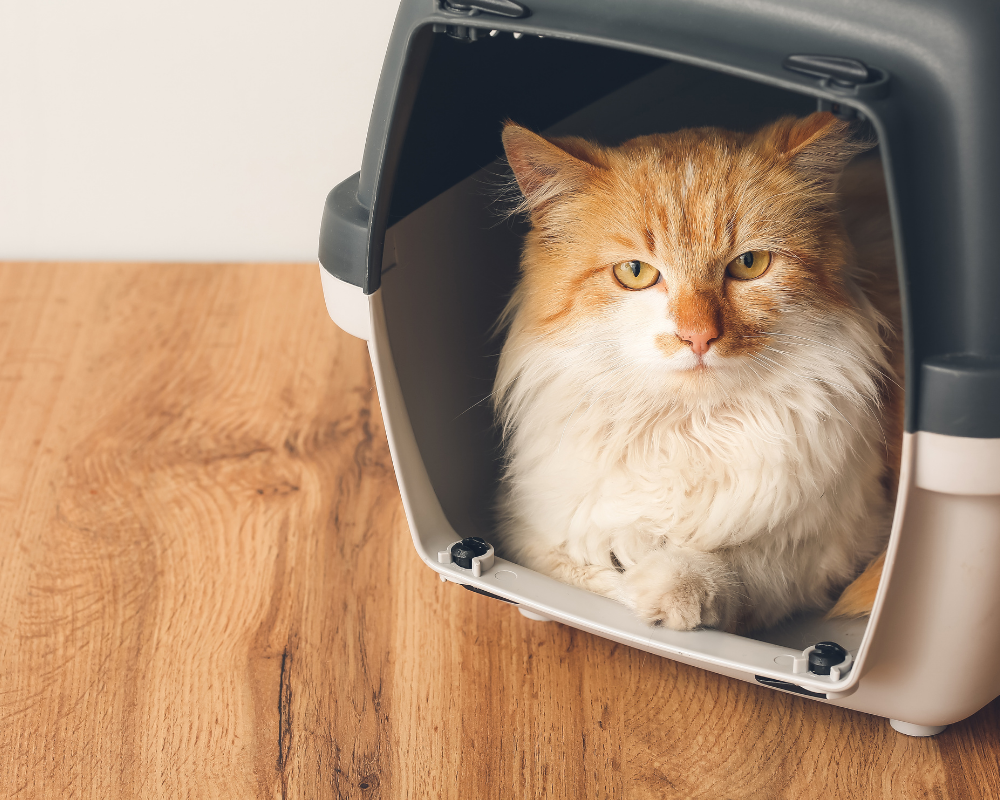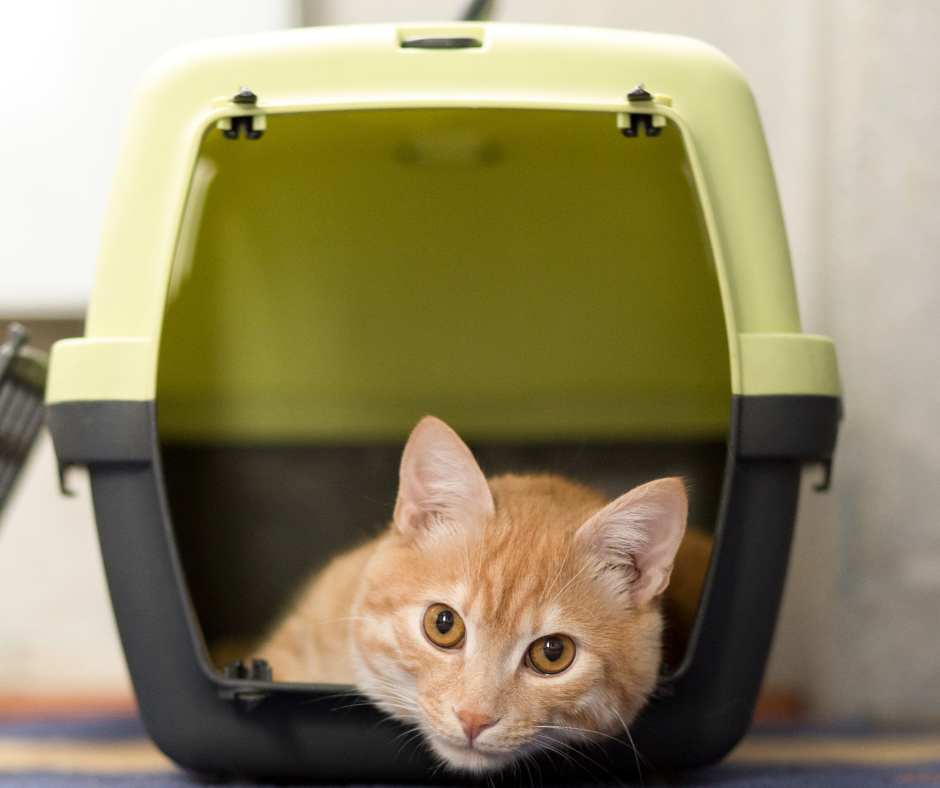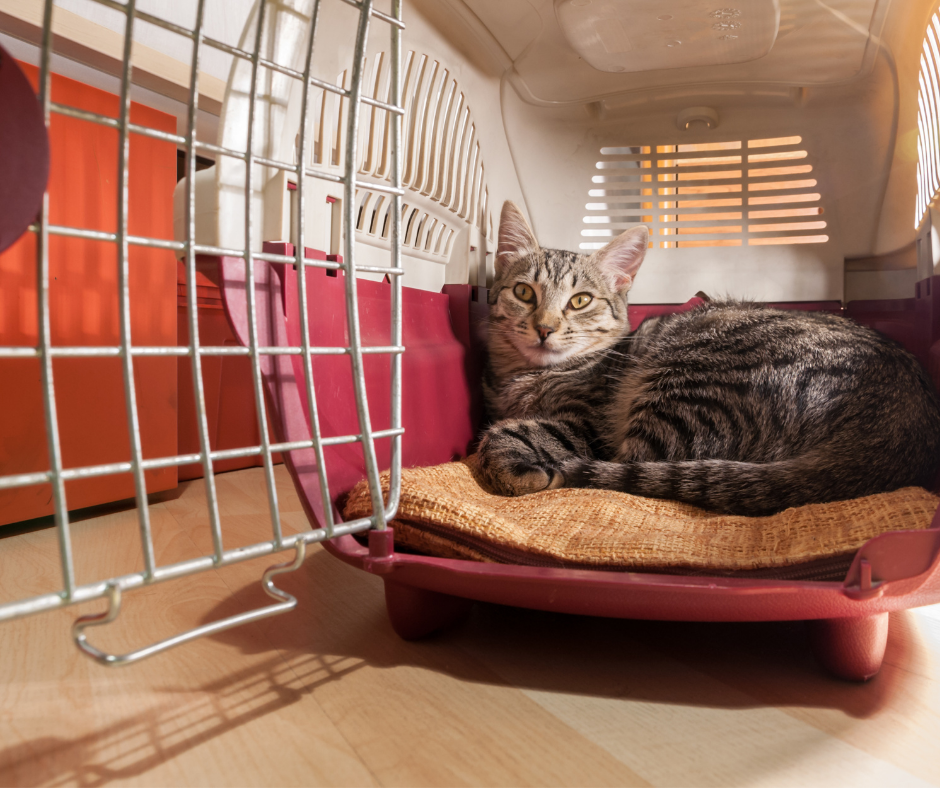We all know that if our cats had an arch-nemesis, it would be their cat carrier. And, for some cats, no amount of treats, trickery or full-on pleading will get them on board! Surely there must be a simpler way…
This article covers how to put your feline into their carrier calmly and safely.

Getting your cat used to their carrier
It’s important to try and get your cat used to their carrier from a young age so they see it as a normal part of their home, rather than a demon box that only appears when they have that dreaded car ride to the vets or the cattery. By having your cat carrier out in your home, you allow your fussy feline to walk in and out freely and become familiar with the cat basket- they may even nod off in there!
You can also put your cat’s treats, favourite blankets and toys in the carrier so your cat associates it with positive things. And you can also spray the inside with a pheromone spray, as your puss will be able to recognise these pheromones, which will help them to feel more relaxed and comfortable in their carrier.
All of these techniques will allow your cat to think of going into their carrier as a positive experience. And, for many cats, this can change their behaviour, making them want to go into the carrier more and also causing them to feel less stressed when they’re inside the carrier. And, by changing your cat’s behaviour, and getting them to do something that they wouldn’t normally want to do, you are successfully training your cat!
How to put your cat in their carrier
The first and most important thing to remember when putting your cat into their carrier is to remain calm and be gentle. As frustrating as it may be, getting worked up will only make your kitty more worried and stressed and they will probably try to run away, or may even become aggressive, making the process even more difficult for both of you.
Start by lining your cat’s carrier with newspaper followed by a familiar non-slip blanket or vet bed. Then make sure you give your cat plenty of opportunities to investigate the carrier, as some felines (especially kittens) will just walk straight in, especially if you have trained them to get used to the carrier.
Try to avoid forcing your cat into the carrier, as this can be very frightening for them, and may send them into a panic. However, if you can’t get your cat won’t go into their carrier voluntarily, it’s time to decide whether you are going to put them into the carrier head or bottom first.
Head-first: if you are trying to put your cat in head first, place one hand under their chest, with the other supporting their bottom and slowly lift them into the carrier. Be sure to promptly shut the carrier door behind them, as cats will often try and spin around to escape. But always make sure you’re not going to accidentally trap their ears, paws or tail first!
Bottom-first: the advantage of this technique is that your cat won’t see the carrier coming, however you may be more likely to get nipped or scratched! Again, gently hold your cat’s chest with one hand and bottom with the other and either lower your cat into the basket, with the carrier facing upward, or carry them into a normally positioned carrier (like with the head-first method) again making sure you close the door behind them.
Carriers with detachable lids can make putting your cat into their carrier so much easier! By removing the lid from your cat carrier, you will be able to place your puss into the lower half of the carrier before gently replacing the lid and quickly closing the door. This is the best way to get most cats into their carrier because many felines will panic and resist more if they are put into their carrier through the front door as this smaller opening will often feel make your cat feel more confined.
Before you leave the house with your cat in their carrier, always make sure the top of their carrier is securely attached, and that the carrier door is locked- as you don’t want an escapee! But it’s always worth making sure your cat’s microchip details are up-to-date so you’re prepared for any worst-case scenarios. It’s also a good idea to place a blanket over the front of your cat carrier, as this can help your puss to feel secure and safe.

How big should your cat’s carrier be?
It’s important to have a carrier that is large enough for your cat to be able to turn around inside, but not so big that your cat may slide around and hurt themselves when travelling. It’s also important not to put more than one cat in each carrier- even if your cats get on well- as cats don’t like to be in confined spaces together and may become aggressive.
The ideal cat carrier
Cat carriers come in all shapes, sizes and materials, and there are a few key things to look out for when selecting a new carrier. A carrier that’s perfect for your puss should ideally:
- Be large enough for your cat, but not too big!
- Have a detachable lid, to easily get your cat in and out.
- Be made of a sturdy, cat-safe material such as plastic.
- Have sides that are not see-through, as this will allow your cat to hide and feel safe when travelling.
- Have a door at the front and the back (not many carriers are made this way but having two doors can make getting your cat out of their carrier much easier, as they tend to squish themselves into a ball right at the back of the carrying basket).
Cattery and kennels
When taking your cat to a cattery, kennel or cat hotel, it’s important to try and find one that’s relatively close by. This is important because cats don’t like to travel for long distances in the car and may become stressed. So, the less time your pet is in the car travelling, the better!

How to train a cat
Cat training is defined as shaping a cat’s behaviour through positive reinforcement, which basically means getting them to do certain things (like walking into their cat carrier or letting you check their paws) by making the experience more positive (with familiar items or pheromone sprays) or by rewarding them afterwards (normally with treats).
Unlike dogs, cats are not able to read our behaviour as well and don’t have the innate desire to please us in the ways dogs do. This means that the best way to motivate them to do something is through food.
Cat training can be used to get your cat to do all kinds of useful things, from getting them into their carrier stress-free, to allowing you to have a good look at their teeth. And training is also brilliant for strengthening your bond with your feline friend, as well as improving their happiness by stimulating their mind and preventing them from becoming bored.
That being said, it’s important to not have too higher expectations, as it can take some time for your puss to learn new things. It’s also vital that you always view training as a fun game with your cat. Don’t become frustrated if your puss doesn’t learn something straight away and never punish your furball, as the best way for your cat to learn is in a happy and relaxed environment.
What’s the best age to train a cat?
If you’re going to start training your cat, it’s best to start from a young age, as kittens will often find it easier to learn new behaviours. That being said, adult cats can also be very receptive to training- so you can teach an old cat new tricks!
Want to know more about cat training? Check out our article, ‘Do cats play fetch?’ here.


